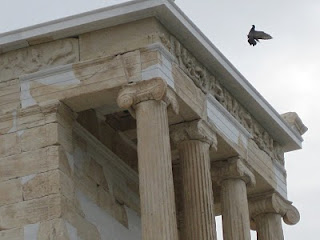
Good things are still happening. This is the end of a dismal year, with all sorts of further calamities presaged for the incoming one. But we should not dwell endlessly on the disasters -there will be plenty of opportunity for that. Rather it is fitting to celebrate a unique event, one which has been buried under the senseless sound and fury of the ongoing political and economic ructions.
The temple of Athena Nike on the Acropolis has been finally re-erected on its original site and it is now once again shining in its unique splendor despite the ravages of so many centuries. Its latest disappearance dates from about a decade ago when it was completely dismantled in order to repair not only structural damages from the erosion of its foundations (it was tilting about five centimeters on its south side) but also the mistakes of previous restorations back in the thirties of the previous century. It has now been fitted with new architectural elements made of Pentelic marble that are clearly visible since they have not yet acquired a patina. Before this, its previous demolition dates from 1687 when the Ottomans tore down the classical temple still standing in its place, for the purpose of building a higher battlement on that vulnerable side of the Acropolis fortress. The Venetians of Morosini were besieging the Hill after having retaken the entire Peloponnese -the warrior Doge having been awarded for this feat the honorary appellation Peloponnesiacus by the Council of the Serenissima. It was during that siege that the Parthenon itself was hit by a shell that caused frightful damage to its south side. Now this jewel of Callicrates is once again projecting its stupendous beauty into the Attic sky, wonderfully counterbalancing the massive presence of the predominantly Doric Propylaia with its intricate Ionic grace. We might spoil this extraordinary story by noting that the erection of this temple is symbolically associated with the ambitions of Athens to exercise political control over Egypt during the peak of its imperial reach, but as I said in times like this it is well worth celebrating the positive dimensions of the historical process. We are heirs to supreme artistic glory long after the power schemes of politicians (even world-historical figures like Pericles) have irrevocably perished.
When I visited the Hill a couple of weeks ago the sky was cloudy with the sun occasionally breaking through. The temple glistened with well-deserved self-satisfaction. All kinds of dark prophesies circulating at the time of its disappearance, to the effect that it had been spirited away by faceless enemies to be sold to foreign museums, had been proven false.
As I was taking pictures a pigeon came in to land on the roof. I am sure it had no inkling of the sacredness of its intended perch. I hope it did not leave any permanent mess behind.

No comments:
Post a Comment